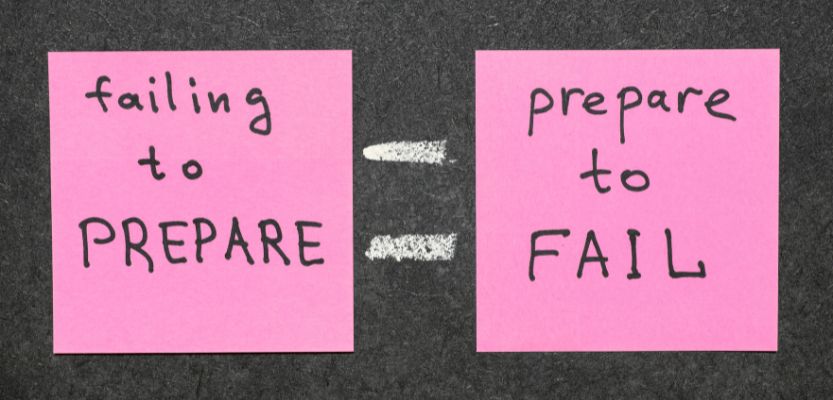Why people should prepare for presentations
(and don’t)
Most people know that preparation is GOOD THING when it comes to public speaking but not everyone knows HOW to prepare for presentations.

Why don’t people prepare for presentations?
Here are four reasons people cite the most often.
- I don’t have the time
- I don’t know how to (I spend lots of time preparing but it doesn’t seem to work)
- Lack of clarity (it all seems so unwieldy)
- Lack of practice (and feedback)
Before delving into the some of the ways we can prepare more effectively, let’s start off with exploring why preparation is necessary.
Winging it might work for casual conversations, but in public speaking, preparation is key.
Waffle is King
Speakers who aren’t well-prepared often ramble, lose their train of thought, or forget important points. This undermines their credibility. This is not only disrespectful of the audience, but also fails to engage them. I have been in many a presentation where the speaker has eventually worked their way through their material after lots of repetition, loops and waffle but lost most of the audience on the way.
High Stress Levels
Lack of preparation is another layer of stress for the speaker. Having to think on the spot, keep track of where you are, thinking of new material and dredge up facts and stories on the cuff sounds more exciting in the saying than in the practice. Lots of people tell me they love the thrill of the spontaneous and speaking form the heart. For most people though, this reliance on the moment, can mean that they are not delivering at their best and their message doesn’t land well. There are ways of capturing the energy and thrill of speaking without compromising the preparation.
Too long and too rote
If you have ever been to a presentation that has run over time, then the chances are that the preparation has been lacking. Saying your talk out loud the way you want to deliver it on the day is crucial. (this is very different than practicing in your head driving to the venue or ‘running through the slides’ quickly the night before.
What’s the point?
Critically, the biggest reason of all for preparing, is to be clear on the message you are delivering. This is the difference between the content and the message. The difference between what you will be saying and the take aways you want the audience to receive. The difference between the what you want to say and what they need to hear. If your time to prepare were limited, this is where I would recommend you spend it. Once this is clear, everything else falls into place.

So, how do we address the problems that get in the way of preparing effectively?
Time:
The reality is that however little time we have to prepare for presentations, most of us waste it. Given a month to prepare we leave it to the last week, given a week, we leave it to the last day, given a day we leave it to the last hour… Even if our time is limited, we can make more efficient use of it by understanding a process. Starting with the end in mind is helpful so you can plan in all the critical partsof the process (including time to practice)
Building Credibility:
Public speaking allows you to connect with your audience on a personal level. By sharing your story, experiences, and passion for your subject, you create a deeper connection that fosters trust and credibility. The more you connect with your audience, the more likely they are to see you as a reliable source of information and a credible expert. If you are representing your organisation, this reflects back on the organisation.
Process
Many people open up the laptop and create slides as the first part of their preparation. That way, they reason, they have the structure in place and all they need do is ‘talk around the slides’. What happens in reality is that there is a download of information, often too much and too detailed and a boring Death by PowerPoint delivery. A process that starts with Clarity of Message, Crafting of presentations and practice of Compelling delivery means that we put the focus on the parts of the presentations that make the difference and use our time wisely. (the three C’s).
Watch this vlog to understand why you should open the laptop after you have prepared for presentations.
Clarity of Message:
Lots of presentations are built around content. Clearly, the quality and curation of content is key but unless there is a clear message and clarity about that message, then the content often misses the mark. Downloads of information can be achieved in reports, memos and manuals. Speaking in public is an opportunity to deliver a message – the meaning, the interpretation, the insights – using content to do so. When we start with clarity of message, we can choose and craft our content so it is working hard for us and brings home the message to the audience effectively.
Practice, practice, practice:
When time is tight and the pressure is on, the vital part of the process that gets squeezed is the ‘practice out loud’ part. You tell this, when you see beautifully designed slides, a clear structure but a poor or hesitant or boring delivery. At the end of the day, the audience is going to experience your talk – and that will come through how YOU deliver, not the slides or the structure. The only way you will know what it will sound like, it to sound it out. Having feedback on your delivery is a key way of testing your message and content out and refining and polishing your talk.
Preparation is key:
knowing how to do it well, can transform your speaking experiences.
If you’d like help preparing a presentation and need some help, let’s chat – get in touch.